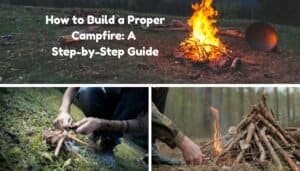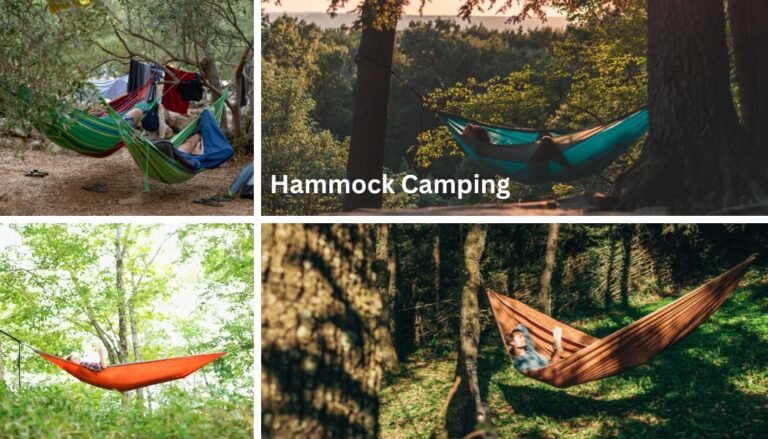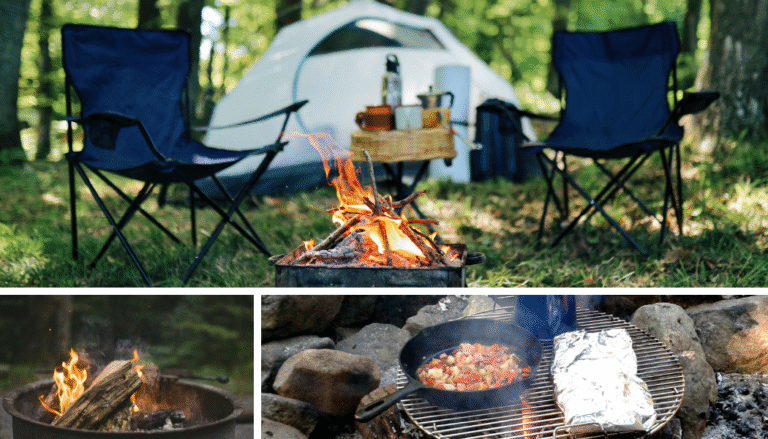Why Knowing How to Build a Proper Campfire Matters
There’s something magical about gathering around a campfire – the crackling wood, glowing embers, and warmth it provides are unmatched! Whether you’re a seasoned camper or just starting, knowing how to build a proper campfire is essential for both safety and enjoyment. I’ll guide you through every step, ensuring your campfire burns brightly and responsibly. Did you know that 85% of wildfires are caused by human negligence? Let’s make sure your fire is not one of them!
Choosing the Right Location for Your Campfire
It took me a while (and a few close calls) to truly appreciate how important it is to pick the right spot for a campfire. One time, I was camping with friends and thought I’d found the perfect spot—flat ground, plenty of space. What I didn’t notice was the overhanging branch right above where we lit the fire. Let’s just say the branch didn’t appreciate the heat. Luckily, we caught it before anything bad happened, but it was a wake-up call about how critical it is to think ahead when setting up a campfire.
Importance of Selecting a Legal and Safe Site
First things first, always make sure you’re allowed to have a campfire where you’re camping. National parks, state parks, and even some private campgrounds have strict rules, and for good reason. Fires can spread faster than you’d think, and you don’t want to be the person responsible for damaging a beautiful spot – or worse, starting a wildfire. When in doubt, check the local regulations or ask the campground host.
Also, look for signs that mark designated fire zones. If it’s not clear, a quick conversation with a ranger or staff can save you from a lot of headaches. I’ve seen people get fined or told to put out their fire in the middle of dinner and trust me, that’s no fun.
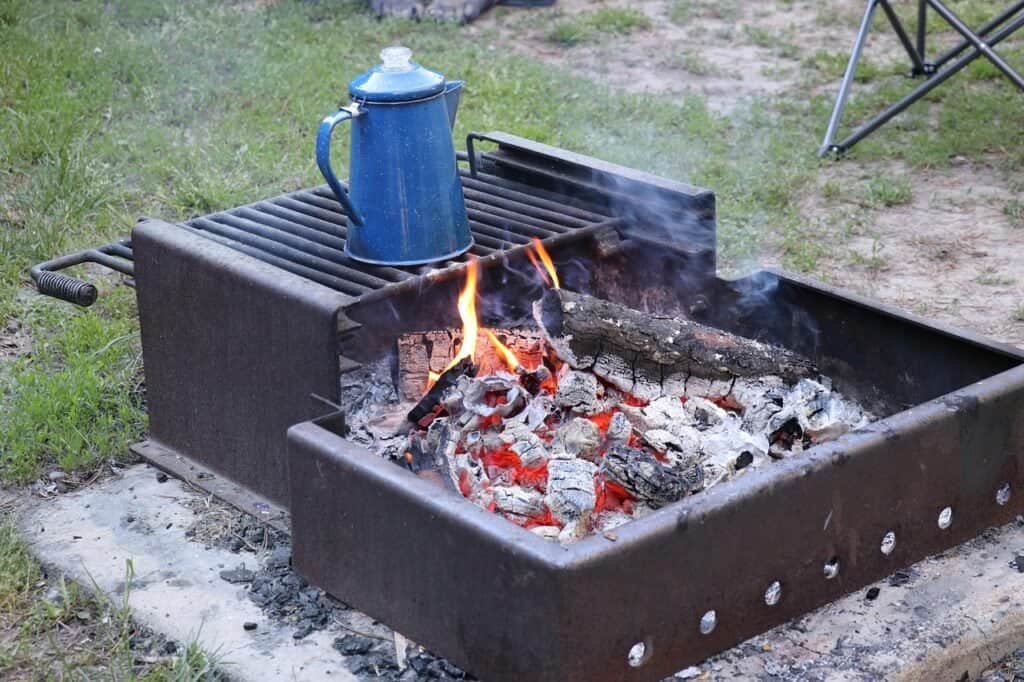
Distance from Tents, Trees, and Overhanging Branches
Here’s a golden rule: always keep your fire at least 15 feet away from tents, trees, and anything else that could catch fire. Even if the fire seems small and manageable, a stray ember carried by the wind can ruin your night and your gear. Plus, the smoke can make sleeping in your tent a nightmare.
And those overhanging branches? They’re sneaky. Always look up before you settle on a spot. I can’t tell you how many times I’ve seen someone pick a spot that looks great from ground level, only to realize later that the branches above are a fire hazard.
Utilizing Existing Fire Rings or Pits
If there’s an existing fire ring or pit, use it. These are usually placed in spots that are safe and away from hazards. Building a new one might seem like a good idea, but it’s a lot of work and could damage the environment. Plus, it’s usually against the rules in most established campgrounds.
When I camped in a remote spot without a fire ring, I made the mistake of not properly clearing the area first. The fire was fine, but the charred spot I left behind was a mess. It felt like I was leaving a scar on the land. Now, I always look for existing pits or, at the very least, clear a wide area down to bare soil if I need to start from scratch.
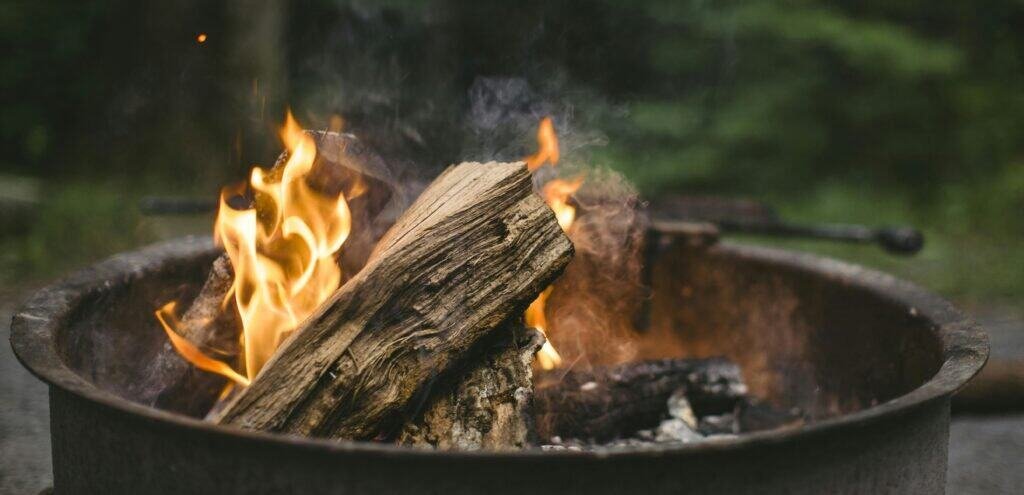
Checking for Wind Direction and Weather Conditions
The wind is sneaky. Even a light breeze can blow sparks where you don’t want them to go. Always check the wind direction before lighting your fire. Set up so the wind blows smoke and embers away from your tent and sitting area. A little planning goes a long way.
Weather is just as important. If it’s been super dry, skip the fire altogether. And if rain’s on the horizon, consider how the fire will hold up – or if it’s even worth starting. A friend of mine learned this the hard way when a sudden downpour drowned our fire and left us with a soggy pile of wood.
In short, choosing the right spot for your campfire isn’t just about convenience – it’s about safety, responsibility, and respecting the environment. Once you’ve got it down, you’ll never look at campfire setup the same way again!
Gathering the Necessary Materials
When it comes to building a campfire, the materials you gather can make or break your night. I’ll admit, there was a time I thought I could throw some big logs into a fire pit, light a match, and voilà – instant flames. Spoiler: that doesn’t work. A good campfire requires preparation and the right materials; trust me, you’ll thank yourself later for getting it right.
The Three Types of Fuel: Tinder, Kindling, and Firewood
Building a fire is like assembling a puzzle – you need the right pieces, and they all serve a purpose. Start with tinder, which is the smallest and most delicate fuel. Think of dry leaves, pine needles, or even crumpled paper if you’re in a pinch. Tinder catches the initial spark, so it’s got to be bone-dry and easy to ignite.
Next up is kindling, which bridges the gap between tinder and your larger fuel. Small sticks about the thickness of a pencil are perfect. These burn hot enough to ignite the larger logs. Finally, there’s the firewood, your main fuel source. Aim for logs that are about the thickness of your forearm. Too big, and you’ll struggle to get them going. Too small, and they’ll burn out quickly.
Selecting Dry, Seasoned Wood
Here’s a lesson I learned the hard way: not all wood is created equal. If you want a fire that burns steady and bright, you need dry, seasoned wood. This is wood that’s been cut and left to dry for at least six months to a year. It’s lighter, less sappy, and makes a satisfying “crack” when you knock two pieces together.
Wet or green wood might look fine, but it’s packed with moisture. This leads to frustrating, smoky fires that don’t burn well. Look for wood with a grayish or split appearance – it’s a good sign it’s ready to burn.
Why Avoiding Green or Wet Wood Matters
One time, I made the rookie mistake of trying to burn green wood. It hissed and smoked like crazy, but actual flames? Barely any. Green wood contains a lot of water, which the fire has to evaporate before it can burn the wood itself. This not only wastes time but creates a ton of smoke, which can be a major buzzkill when you’re sitting around the campfire.
Wet wood has similar issues but with the added frustration of being harder to light in the first place. Plus, all that smoke isn’t great for your lungs—or your camping neighbors if you’re sharing a campground.
Tools You’ll Need: Matches, Lighters, and Fire Starters
You’ll want to come prepared with reliable tools to actually start your fire. Matches and lighters are a given but don’t underestimate the value of a good fire starter. I always keep a pack of fire-starting cubes in my gear – they’re lifesavers, especially when everything feels a little damp.
If you’re feeling old-school, bring a magnesium fire starter. It’s fun to use and works great for sparking tinder. One time, I forgot my matches and had to get creative with flint and steel. It worked, but wow, it was a workout. Lesson learned: always pack a backup.
Having the right tools and materials on hand makes the process so much smoother. Once you’ve gathered everything, building a fire goes from frustrating trial-and-error to something almost magical. Nothing beats the feeling of seeing those first flames catch fire!
Building the Campfire: Step-by-Step
If there’s one thing that turns an ordinary camping trip into a cozy adventure, it’s a well-built campfire. But let’s be real – it’s not always as easy as it looks in the movies. I’ve had my fair share of smoky disasters and stubborn flames, but through trial and error, I’ve learned how to build a campfire that actually works. Let’s break it down step by step.
Creating a Fire Pit if One Isn’t Available
First things first – if you’re at a campsite without a designated fire ring, you’ll need to create your own. Start by choosing a flat, clear area away from trees, bushes, or anything flammable. Trust me, you don’t want your fire to wander. Dig a shallow pit about six inches deep and surround it with a ring of stones to contain the fire.
One time, I skipped the stone circle, thinking, “How bad could it be?” Turns out, embers travel further than you’d expect. Luckily, nothing caught fire, but I learned my lesson: always take the time to secure the area.

Arranging the Tinder, Kindling, and Firewood
Now that you’ve got your fire pit, it’s time to layer your materials. Think of this like building a house – you need a strong foundation. Start with a generous pile of tinder in the center. On top of that, add your kindling, but leave enough space for airflow. Fire thrives on oxygen, so don’t pack everything too tightly.
Finally, arrange your firewood around the kindling. Don’t overdo it with the big logs right away; start small and gradually add larger pieces as the fire grows. When I first started camping, I’d toss huge logs on the pile right away. The fire would smother itself, and I’d be left staring at a sad pile of smoke.
Popular Campfire Structures: Tepee, Log Cabin, and Lean-To Designs
Different fire structures work better for different purposes.
Tepee: This is the classic setup and is great for beginners. Arrange your kindling and small logs in a cone shape, leaving space for air to flow through. It lights quickly and burns hot, making it perfect for cooking or just getting warm fast.
Log Cabin: Stack your firewood in a square pattern, like building Lincoln Logs. Place your tinder and kindling in the middle. This burns slower and more evenly, which is great if you’re sitting around for a long chat.
Lean-To: Prop a larger log at an angle, resting on a smaller one. Place your tinder and kindling underneath. This design works well in windy conditions because it shields the flame while still providing airflow.
I’m a tepee fan myself – it’s easy to set up and feels foolproof. But when the wind picks up, the lean-to has saved me more than once.
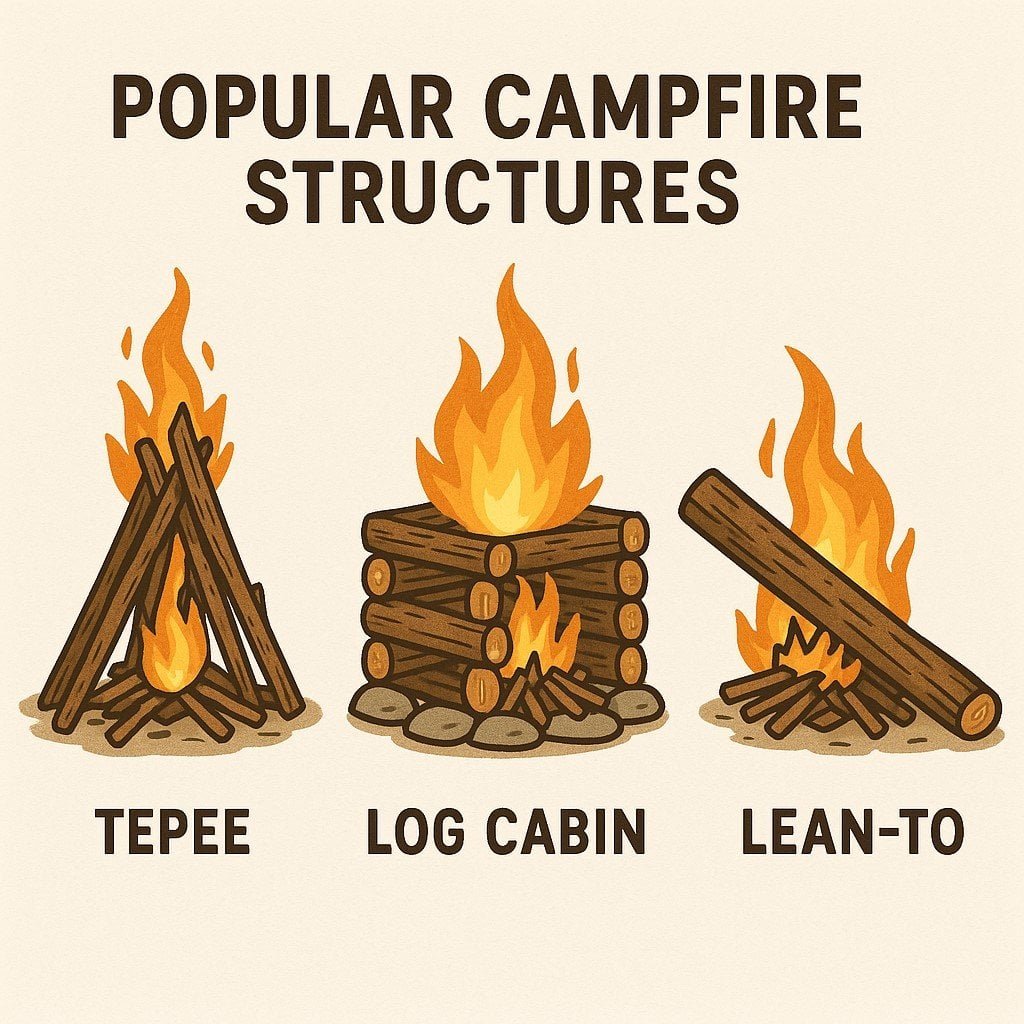
Tips for Igniting the Fire Effectively
Lighting the fire can feel like the moment of truth. Start by igniting the tinder at several points to get it burning evenly. A long match or a lighter with an extended nozzle is your best friend here – no one likes singed fingers.
Blow gently at the base of the fire to help it catch, but don’t go overboard. One time, I got a little too enthusiastic with the blowing and scattered my carefully built tepee everywhere. Lesson learned: patience is key.
If the tinder seems stubborn, consider adding a fire starter. These little wonders are especially handy if the weather’s damp. And always keep a bucket of water or a shovel nearby – better safe than sorry.
With the right setup and a little practice, building a campfire becomes second nature. There’s something so satisfying about sitting back and watching those flames dance, knowing you built it from scratch. Plus, the marshmallows just taste better over a fire you made yourself.
Campfire Safety Tips to Follow
When it comes to campfires, safety isn’t just an afterthought – it’s the cornerstone of a good camping experience. Nothing ruins a peaceful night under the stars faster than a fire gone rogue. Here’s what I’ve learned (sometimes the hard way) about staying safe while enjoying the warmth of a campfire.
Never Leave the Fire Unattended
This one seems like a no-brainer, but you’d be surprised how easy it is to get distracted. Whether you’re off exploring a trail, grabbing more marshmallows, or just stepping away to grab your phone, never leave the fire alone. Embers can reignite or spread before you know it.
Once, I left my campfire to “just grab a jacket” from the tent, and by the time I came back, a gust of wind had scattered embers onto some dry leaves nearby. Thankfully, I caught it in time, but that little scare drilled the lesson into me: if you’re not watching it, extinguish it first.
Keeping Water, Sand, or a Shovel Nearby
A campfire isn’t something you set and forget. Always have a way to control it within arm’s reach. I usually keep a bucket of water and a shovel nearby, and if I’m camping in sandy areas, a pile of sand is an excellent backup.
One trick I picked up is to douse the fire with water in stages when putting it out. Pour water slowly, stir the ashes with a stick or shovel, and repeat until everything is cool to the touch. I’ve made the mistake of thinking a fire was out, only to find smoldering embers the next morning.
Understanding Fire Bans and Restrictions in Your Area
Fire bans and restrictions aren’t just bureaucratic red tape – they’re there for a reason. Dry conditions can turn a small fire into a massive wildfire. Always check local regulations before lighting up, especially during summer or in high-risk areas.
I’ve shown up to campsites before, assuming I could build a fire, only to see “No Fires” signs posted everywhere. Now, I make it a point to check online or call ahead to confirm. Trust me, getting fined for breaking fire rules is not the kind of memory you want to make on a camping trip. Some fire bans allow for the use of propane fire pits.
Educating Kids and Newcomers About Fire Safety
If you’re camping with kids or first-timers, don’t assume they know the dos and don’ts of fire safety. Spend a few minutes explaining the basics: no running around the fire, no tossing trash into the flames, and absolutely no poking at burning logs.
I remember taking my nephew on his first camping trip. He thought throwing pinecones into the fire was “super cool” until one popped and sent sparks everywhere. That little incident turned into a teachable moment about why certain things shouldn’t go into the flames.
It’s also a good idea to model safe behavior. Keep a safe distance from the fire, and show others how to properly tend to it. Actions speak louder than words, and kids, especially, are more likely to follow your lead than your lectures.
Campfires bring people together, but they also come with a responsibility. By following these safety tips, you can enjoy all the cozy, crackling goodness without the stress of an accident. And honestly, when you know your fire is secure, it’s so much easier to relax and soak in the camping vibes.
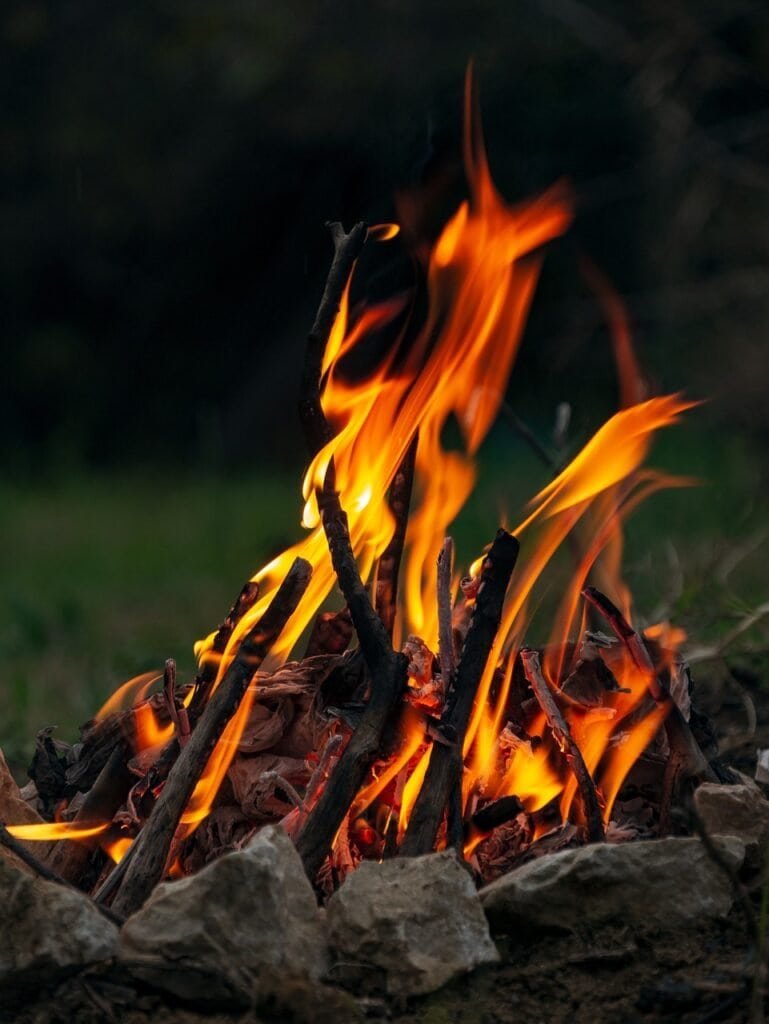
Extinguishing the Campfire Properly
Putting out a campfire might not be the most glamorous part of camping, but it’s arguably one of the most important. A fire left smoldering can reignite hours or even days later, leading to dangerous situations or environmental damage. Here’s how I’ve learned to handle this task the right way, with some tips that might save you trouble – or embarrassment – in the future.
Why It’s Crucial to Put Out the Fire Completely
I’ll never forget the first time I truly understood the stakes. I thought I had put out a fire well enough, only to wake up at 2 a.m. to a faint glow coming from the pit. It turns out hot embers can linger for a long time, especially if there’s a bit of wind to stoke them.
Leaving a fire burning, even slightly, isn’t just careless; it’s potentially devastating. Wildfires can start from embers smaller than a coin. Always assume that if the fire isn’t completely out, it’s still a risk.
Dousing with Water Versus Using Dirt or Sand
Water is, hands down, the most effective way to extinguish a campfire, but dirt or sand can work in a pinch. When using water, pour it slowly and directly over the fire, aiming for all the embers and not just the main logs. The sizzling sound of the fire going out is satisfying, but don’t stop there. Stir the ashes with a stick and pour more water until it’s all cool to the touch.
If you’re in a place where water isn’t plentiful, dirt or sand can smother the flames. However, be thorough – it’s easy to miss hot embers when you’re just covering them up. I prefer to mix dirt into the ashes, tamping it down as I go to ensure every last bit is smothered.
How to Check if the Fire Is Entirely Out
This is the step a lot of people skip, but it’s critical. After dousing and stirring, hover your hand a few inches above the ashes to feel for any remaining heat. Be cautious—don’t touch anything directly, as embers can still be dangerously hot. If you detect any warmth, it’s not fully out.
I’ve made it a habit to double-check before leaving the site. One trick I use is to kick over the fire pit lightly with a boot or stick, exposing the lower layers of ash. If you see anything glowing or feel any residual heat, it’s time to repeat the process.
Leaving No Trace: Restoring the Area After Extinguishing
Camping responsibly means leaving the site as you found it or better. Once the fire is completely out, scatter any cooled ashes and natural debris back into the surrounding area. If you’ve used a temporary fire pit, dismantle it and replace the rocks or dirt as they were.
I once camped at a site where someone had left a massive, blackened pit with half-burned logs strewn about. It not only looked awful but also sent a bad message about campers to anyone else visiting. Taking those extra few minutes to restore the area shows respect for the environment and future campers.
Extinguishing a fire properly might feel tedious, especially when you’re tired after a long day outdoors. However, it’s a simple yet critical step that ensures your camping trip leaves no lasting harm. Plus, there’s a quiet satisfaction in knowing you’ve done it right, keeping nature and your reputation intact.
Troubleshooting Common Campfire Issues
Building and maintaining a campfire seems simple, right? But anyone who’s ever struggled with a stubborn flame or dealt with a smoke-filled campsite knows it’s not always as straightforward as it looks. Here’s a breakdown of the common issues you might face and how to fix them so you can enjoy that perfect fire.
Fire Won’t Ignite: Causes and Fixes
There’s nothing more frustrating than spending 15 minutes trying to light a fire that refuses to cooperate. I’ve been there, angrily flicking a lighter over and over, wondering if the universe was conspiring against me. The culprit is usually one of three things: damp materials, poor fire structure, or insufficient oxygen.
Start with your materials. Is the tinder dry and easy to ignite? If it’s damp, even the best fire starter won’t help. Gather dry leaves, bark, or even lint from your pocket (it’s a lifesaver!). Also, check your kindling and firewood – seasoned wood burns much better than green or wet wood.
Next, review your fire structure. A tepee or log cabin design works wonders because they allow air to circulate through the fuel. Without proper airflow, your fire will suffocate before it even gets going. Lastly, don’t crowd the flames too soon with larger logs. Let the tinder and kindling catch fully before adding anything bigger.
Excessive Smoke: Understanding Why It Happens
A smoky campfire can be a real mood killer. It stings your eyes, makes your clothes reek, and has a knack for following you no matter where you sit. The main reasons for excessive smoke are wet or green wood and improper airflow.
When I was just starting out, I thought any wood lying around would do. Turns out, green wood (from freshly cut trees) or damp wood creates a ton of smoke because it’s full of moisture that needs to evaporate before the wood can burn properly. Stick with seasoned hardwoods like oak or hickory whenever possible; they burn hotter and produce less smoke.
Also, take a look at your fire structure. A tightly packed pile of wood traps the smoke, forcing it to billow out instead of venting upward. Spacing the logs apart slightly and building your fire in a structure like a tepee or lean-to can improve airflow and reduce smoke.
Fire Burns Out Too Quickly: Tips for Maintaining a Steady Flame
There’s something so frustrating about getting a fire started only to have it fizzle out the moment you turn your back. This often happens because the fuel isn’t balanced correctly or because the fire wasn’t built to last.
To keep the flame going strong, make sure you’re feeding it a mix of small and large pieces of wood. If you load it up with big logs too soon, the fire may not generate enough heat to sustain itself. On the flip side, if you only use small sticks, they’ll burn out quickly, leaving you scrambling to add more fuel constantly.
I’ve also found that checking the fire periodically is key. If you notice the flames dying down, give the logs a gentle nudge to shift them slightly. This helps reignite embers and keeps the oxygen flowing. And don’t forget to add fresh wood before the fire dies completely – it’s much harder to restart a fire than to maintain one that’s already burning.
Troubleshooting a campfire can feel a bit like solving a puzzle, but once you’ve cracked the code, it becomes second nature. Pay attention to your materials, structure, and airflow, and you’ll have a roaring fire in no time. Just remember, practice makes perfect, and every failed attempt is a step closer to mastering the art of the campfire.
Your Campfire Adventure Starts Here
Mastering the art of building a proper campfire is a skill that enhances any outdoor adventure. By choosing the right location, gathering the right materials, and following safety protocols, you can ensure a warm, inviting, and responsible fire. Ready to enjoy the great outdoors? Practice these tips on your next trip and create unforgettable moments by the firelight!
FAQ Section
Can I build a campfire anywhere while camping?
No, you should only build a campfire in designated fire pits or rings where allowed. Always check local regulations and fire bans before starting a fire.
What should I do if my campfire won’t stay lit?
If your fire won’t stay lit, check the quality of your tinder, kindling, and firewood. Ensure they are dry and properly arranged. Windy or wet conditions might require additional sheltering or dry fire starters.
What is the safest way to extinguish a campfire?
The safest way to extinguish a campfire is to douse it with water, stir the ashes with a stick or shovel, and add more water until the area is cool to the touch. Never leave a fire smoldering.
What is the best type of wood for a campfire?
Dry, seasoned hardwoods like oak, maple, or birch are ideal for a campfire as they burn longer and produce less smoke. Avoid green or wet wood, as it can create excessive smoke and is harder to ignite.
How can I reduce smoke from my campfire?
To reduce smoke, use dry, seasoned wood and ensure your fire has adequate airflow. Avoid burning materials like leaves, damp wood, or trash, as they create excessive smoke.
Disclaimer: This blog post contains affiliate links

